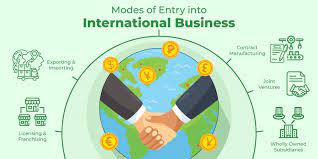Introduction
International business refers to commercial activities that take place across national borders, involving the exchange of goods, services, capital, and technology. The globalization of the economy has led to an increase in international business, creating new opportunities and challenges for companies, governments, and individuals. In this blog, we will explore the key concepts and issues of international business, including cultural differences, market entry strategies, global supply chains, and ethical considerations.
Cultural Differences
One of the main challenges of international business is dealing with cultural differences. Culture refers to the shared values, beliefs, customs, and behaviors that shape the way people think, communicate, and interact. Cultural differences can affect many aspects of international business, including communication, negotiation, marketing, and management. Here are some examples of cultural differences:
Communication styles: Different cultures have different norms for verbal and nonverbal communication, such as directness, politeness, and tone of voice.
Business practices: Different cultures have different expectations for business etiquette, such as dress code, punctuality, and gift-giving.
Decision-making styles: Different cultures have different approaches to decision-making, such as individualism vs. collectivism, and hierarchy vs. egalitarianism.
Attitudes toward time: Different cultures have different attitudes toward time, such as punctuality vs. flexibility, and short-term vs. long-term orientation.
Market Entry Strategies
Another important aspect of international business is choosing the right market entry strategy. Market entry refers to the process of entering a new market or expanding an existing one, and it can involve various modes of entry, such as exporting, licensing, franchising, joint ventures, and wholly-owned subsidiaries. The choice of market entry strategy depends on various factors, such as the size of the market, the level of competition, the regulatory environment, and the company’s resources and capabilities. Here are some examples of market entry strategies:
Exporting: This involves selling goods or services to customers in another country, either directly or through intermediaries, such as distributors or agents.
Licensing: This involves granting a license to a foreign company to use a company’s intellectual property, such as patents, trademarks, or copyrights, in exchange for royalties or fees.
Franchising: This involves granting a franchisee the right to use a company’s brand name, products, and services, in exchange for fees and royalties.
Joint ventures: This involves forming a partnership with a foreign company to jointly operate a business, sharing the risks and rewards.
Wholly-owned subsidiaries: This involves establishing a new business entity in a foreign country, either by acquiring an existing company or by starting from scratch.
Global Supply Chains
Global supply chains are another important aspect of international business, as they involve the flow of goods, services, and information across multiple countries and companies. Global supply chains can offer many benefits, such as access to new markets, lower costs, and increased efficiency, but they also pose many challenges, such as managing complex logistics, ensuring quality and safety standards, and navigating legal and regulatory frameworks. Here are some examples of global supply chains:
Raw materials: Many companies source their raw materials from multiple countries, such as minerals, metals, and agricultural products.
Manufacturing: Many companies manufacture their products in multiple countries, such as electronics, automobiles, and apparel.
Distribution: Many companies distribute their products through multiple channels, such as online retailers, brick-and-mortar stores, and wholesalers.
Logistics: Many companies use multiple modes of transportation, such as ships, planes, and trucks, to transport their goods across borders.




